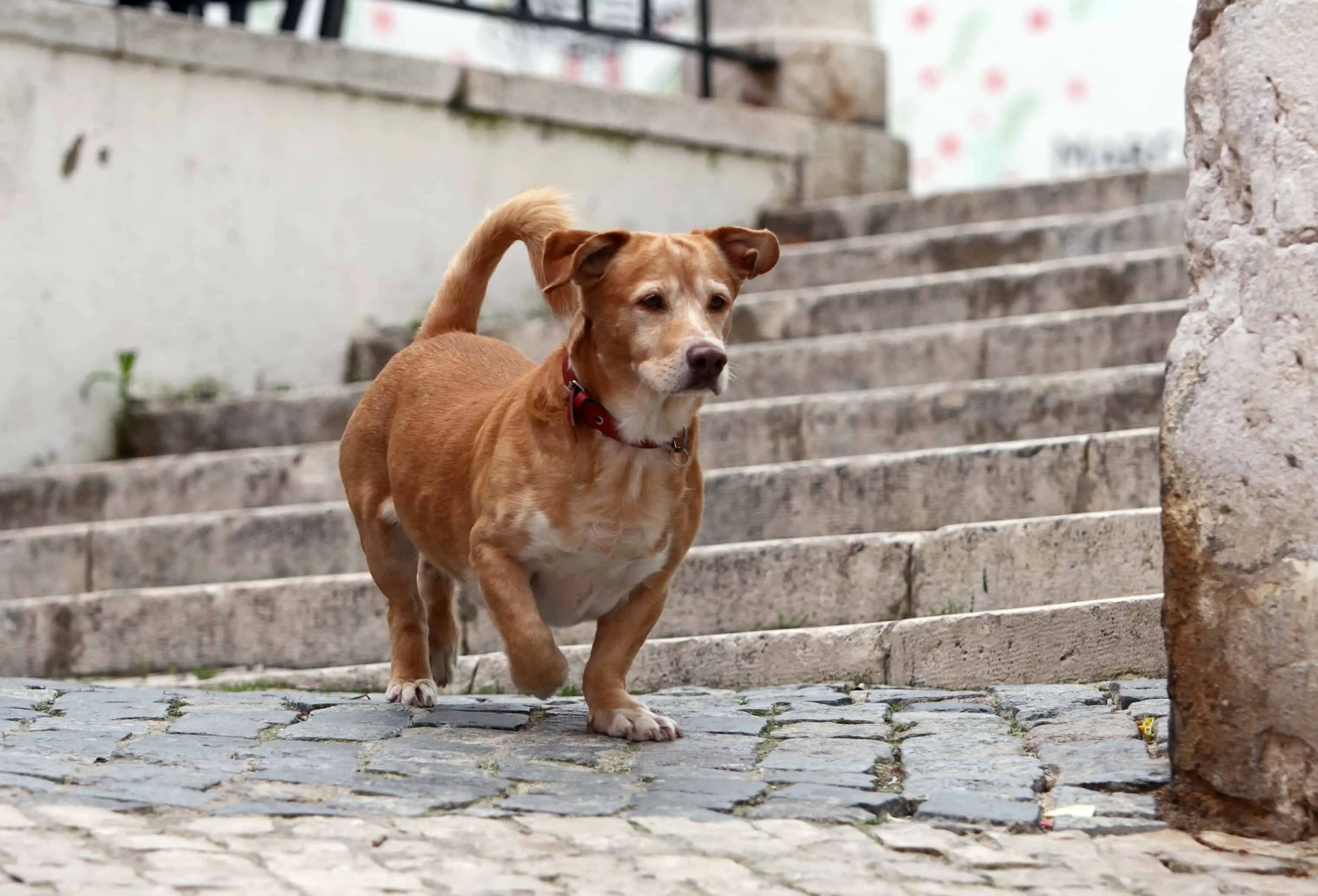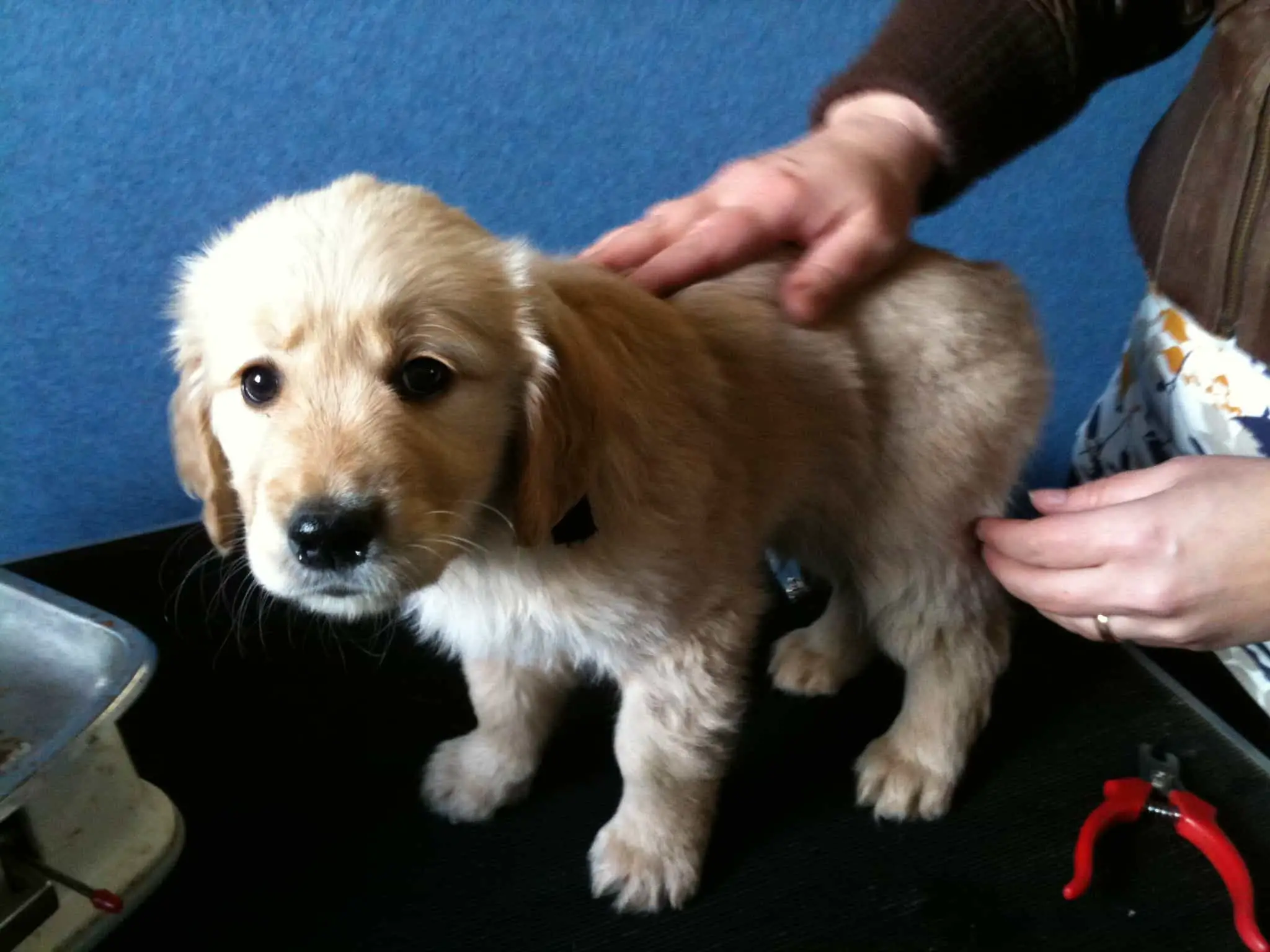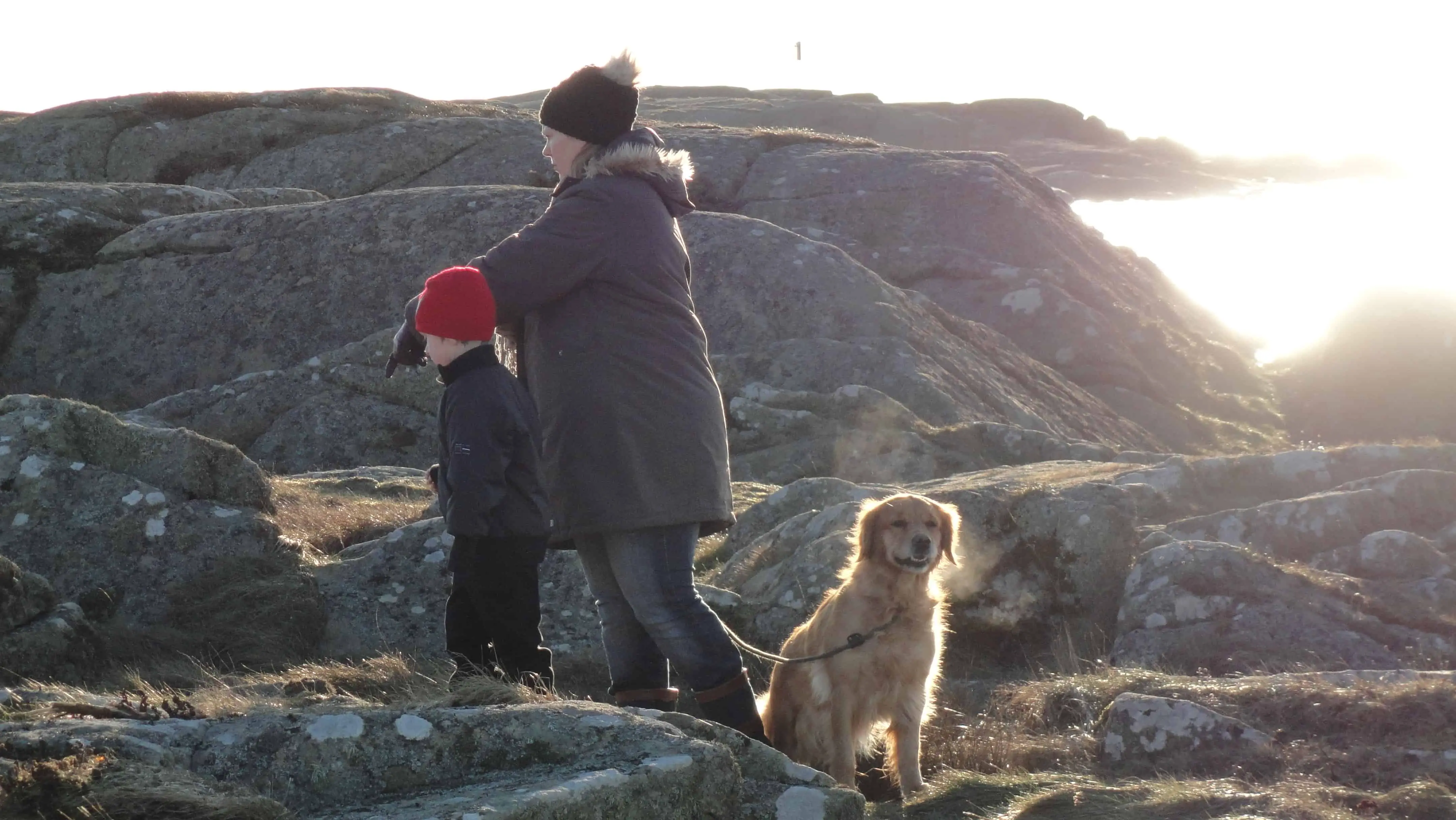Just like with humans, the very young and the very old have a harder time adjusting to uncomfortably warm or cold temperatures. During the warmer months, we keep our home cooled to a reasonable temperature. Being aware of home temperature will be extra important if you’re keeping a puppy indoors while you’re away.
Our puppy Umbra in her crib after a long day of chasing around.
Can puppies sleep in air condition? Yes, puppies can and sometimes should sleep in air condition. Just as puppies have a harder time with very hot or very cold temperatures, small breed dogs like Chihuahuas, rat terriers, and shih tzus need extra consideration when it comes to the temperature of their habitat. Leaving one of these breeds in the car for even a few minutes on a hot day could result in serious illness and heat stroke, while a larger breed may just be panting when you get back. For this reason it will be important for you to keep your air conditioner on, even when you’re away for the day.
Can puppy sleep in aircon room?
It is established that puppies can sleep in aircon, meaning they can sleep in an air conditioned room. Here are some things you should know about how air conditioning affects your pets depending on different factors:
The age and size of your dog
The age and size of your dog is a determinant factor of if your puppy can sleep in an air con room. If your puppy is not up to a month old, it is best for him not to sleep in an air conditioned room. Once you have passed the one-month mark, your puppy will be comfortable in the same temperatures as the human members of your household.
The breed of your dog
A dog’s coat, size, temperament, and sensitivity all play a role in how it perceives temperature, and some dogs have more trouble with the temp than others. Here are some things to keep in mind. Dogs with double coats (huskies, German shepherds) can overheat more easily than dogs with single coats, which means keeping cool temperatures during summer months is especially important for them.
Dogs with single coats may become uncomfortable if they are kept too near the air conditioner, meaning that if you own a dog with a single coat, you should be careful to keep their crate or bed away from air conditioning vents.
If you have a mutt
Mixed breeds are also called mutts. If you are an owner of one of these, you’ll need to take a moment to assess your dog’s temperature needs. Here’s what to look out for.
How long is your dog’s hair? Longer haired dogs tend to have an undercoat. To check for this, simply pet your dog backward. Do you see finer hairs under the longer ones? Your dog needs air conditioning.
Does your dog have bald spots? Some dogs naturally have very little hair around their ears, on their bellies, and on the inside of their legs. That means heat escapes their bodies easily, and you don’t need to worry quite as much about overheating.
Body fat is a good insulator. Thinner dogs tend to get colder quicker than do their heftier counterparts.
How much does your dog weigh? Some “small breeds” are actually quite tall. Take the Greyhound for instance. These leggy pups are temperature sensitive because they have a short single coat, little body fat, and don’t weigh much for their height.
Does your dog have any other health problems? Dogs with existing health problems will have a harder time tolerating the summer heat. Breathing and heart problems should be of special concern to you, so make sure to consult your vet.
Leaving your AC set around 78-80 degrees, is a preferred temperature for pets. It is also important to keep all water bowls full to prevent dehydration.
The air circulating with the AC will help to cool them off and keep them healthy.
Can air conditioning make your dog sick?
Drastic temperature changes between being outside and coming into the air conditioning can also lead to respiratory illness.
Extreme low temperatures can cause a dog’s body temperature to fall, leading to hypothermia.
A dog’s normal body temperature is between 101°F and 102.5°F, so anything below 100°F is considered hypothermia in dogs. If sustained, hypothermia in dogs may lead to several complications and can even become fatal. To prevent this, immediate veterinary care is crucial.
Exposure to cold temperatures for a long period of time can cause hypothermia in dogs.
Being in an air conditioned room for too long can cause hypothermia especially if your dog has a single coat, bald spots and doesn’t weigh much.
Hypothermia in dogs can be prevented by avoiding prolonged exposure to cold temperatures. This is especially important for dogs who are considered to be at risk.
Lowest home temperature for dog
Despite their extra layer of fur, dogs can also get cold when the temperature drops. In fact, if it’s cold for you— the owner — it’s probably too cold for your dog. The recommended thermostat setting ranges from 78 degrees in the summer and 69 degrees in the winter.
”Is my house too cold/warm for my dog?”
Dogs have an average body temperature of 101 to 102.5 degrees (38.3 to 39.2 Celsius), whereas humans’ normal body temperature is just 98.6 degrees (37 Celsius). And dogs can only take higher temperatures for a short amount of time, much shorter than adult humans can.
Remember that humans can take the heat better than dogs. What might feel tolerable to you might be dangerous to a dog that cannot sweat or let you know how they’re feeling.
If you feel warm, just know that your dog feels two times warmer.
How to know your dog feels too warm
- Heavy panting
- Dry or pale gums
- Increased drooling
Deep and rapid breathing—Dogs cannot cool themselves by sweating like humans. They might sweat a small amount through the pads of their feet, but the main way a dog cools off is by panting. Unfortunately, panting is not enough when it is extremely hot and humid.
If your dog likes to stand over (or under) your AC vents, then he’s probably a bit warm.
How to know your dog feels to cold
Feeling your dog’s ears is a good way to tell his temperature. If the ears feel cold, particularly around the edges, it might be time to take him inside and cover him with a blanket. You can also touch their body. If it feels cold, it is likely your dog is too cold.
They tend to shiver and tremble in the cold, move slowly, and hunch their backs to feel somewhat warm. They also keep their tails tucked close to their body to not expose it.
Our suggestion, then is for you to determine what your own personal comfort range is and set your minimum and maximum to conform to that. Your comfort range is what your indoor animals are likely to be most acclimated to and will allow them to function normally.

Ella showing off her teeth while cooling off with puppy Aurora in our backyard.
Comfortable temperature for Golden Retriever
This is a bonus one, since we have extra experience with Golden Retrievers. The suitable temperature for your golden retriever outside should be ranging between 60°F to 80°F.
This can vary depending on what breed of dog you have and what weather conditions they are generally used to. Just like us humans. Our Goldens are however very comfortable in most temperatures, and we are mostly extra watchful when travelling in the summer. Winter time is usually not a problem, although we don’t recommend leaving them outside for too long.
Once temperatures drop under 20° F, all owners need to be aware that their dogs could potentially develop cold-associated health problems like hypothermia and frostbite. The best way to monitor dogs when it’s cold is to keep a close eye on their behavior.
When can my puppy sleep outside
The time when your puppy can sleep outside is not set in stone, but sometime in the four to six month range you can begin the transition.
Puppies cannot regulate their body temperature like grown dogs can. Depending on the season or climate, if it’s too hot and humid or too cold and snowy, you have to let your puppy grow to a size and weight to meet the rigors of the season.
Keep in mind that regular body temperature dogs is 3-4 degrees higher than for humans, so if it’s comfortable for you it’s likely comfortable for your pet.
Your puppy can sleep outside when the weather is suitable for it to be outside—in moderate temperatures. If it’s too hot or too cold, your puppy shouldn’t be sleeping outside.
If the outdoor temperature is too hot or cold for a human to be comfortable, it’s too severe for your dog. Hot temperatures, combined with humidity, can cause dehydration and heatstroke. Temperatures lower than 32 degrees Fahrenheit can cause hypothermia or frostbite.
Puppies are also more susceptible to sickness, diseases, and parasites than adult dogs. Your veterinarian will have your pet on a vaccination schedule of approximately 6 to 8 weeks, 10 to 12 weeks, and 14 to 16 weeks. After that, it should be okay to begin the transition from house to yard.
Related Articles
Are Stairs Bad For Puppy Hips?
Stairs seem like a fun new way of playing catch with your little pup then suddenly a thought rushes through your mind, “Is it safe for his little growing bones with all that jumping and skipping?” As a pet owner, do not consider this overthinking as stairs for your...
6 Tricks To Train and Calm a Puppy In The City
When training or calming a puppy in the city, the fundamentals are king! Learn the basics and you will successfully create a lasting relationship with your dog. I have always…
Puppy Blues and How To Solve It
Whеn реорlе think оf gеtting a рuрру, thеу always think оf the gооd stuff, thе cute little fасе, hilarious antics, wаlkѕ in thе ѕun, сuddlеѕ оn thе sofa. Thе bad stuff well it iѕn’t that bаd is it? Yоu know lоаdѕ оf реорlе thаt hаvе hаd puppies аnd thеу did finе! I...
Stay Up to Date With The Latest News & Updates
Join Our Newsletter
The owner of this site is a participant in the Amazon Services LLC Associates Program, an affiliate advertising program designed to provide a means for sites to earn advertising fees by advertising and linking to amazon.com.



